╔
An Innovation District is a specific urban environment, where individual talent and organizations work in knowledge-intensive industries to solve complex problems. Innovation districts activate the dormant capabilities of a community and generate exponential benefits for surrounding neighborhoods and regions. In order to succeed in their endeavour, the civic leaders of innovation districts typically constitute a knowledge ecosystem, consisting of a combination of universities and research centers, innovation centers, technology and knowledge transfer spaces, startup incubators, leading innovative companies, and solid value chains of supplies and providers operating within physical proximity.
Port environments present a number of strategic advantages when it comes to identifying attractive locations for a potential innovation district. Why? The reason lies in the set of ingredients and dynamics that are typically required for an innovation ecosystem to succeed. Critical ingredients behind the success of innovation districts typically include a compact urban design typology, medium-high levels of urban density, a tightly knit ecosystem composed of compatible public and private agents operating in synergy, access to talent, and advanced industries presenting a global comparative advantage. In this article, we review the three main types of innovation districts being nurtured within port environments, as well as some international examples of every typology, to illustrate the range of opportunities for port cities to successfully nurture and consolidate a vibrant innovation district.
Generally speaking, leading port authorities tend to benefit from a strategic location, geographic proximity to globally competitive industries, a high degree of network centrality from a global supply chain perspective, solid intermodal logistics infrastructure and operational systems, high value added activities, and closeness to downtown areas hosting local and international talent. However, other critical components are fundamental to ensure the success of an innovation district.
Ingredients and Dynamics Behind the Success of Innovation Districts: The Seven Phases of Innovation
The Seven Phases of Innovation provide a framework for organizations to create support systems to promote innovation efforts of startups and young companies. Creating startup competitions, accelerators, boot camps and conferences will help to increase excitement and provide opportunities for new company creation. In addition, providing legal, IP, financial advice and mentorship during the startup process will help to remove obstacles and make it easier for individuals and teams to achieve their goals. Successfully nurturing this innovation-friendly environment will require the support of innovative organizations associated with leading research centers and innovative firms, co-working spaces, industry professionals and state sponsorship to achieve its full potential.
During the innovation journey, organizations and communities such as the leading Research and Innovation Institutions need to enable innovators by providing adequate support. The three platforms enabling that journey are University Applied Research Lab, Innovation Centers & Labs / Technology Transfer, and Startup Incubators & Accelerators. Below we discuss how the platforms can be developed.
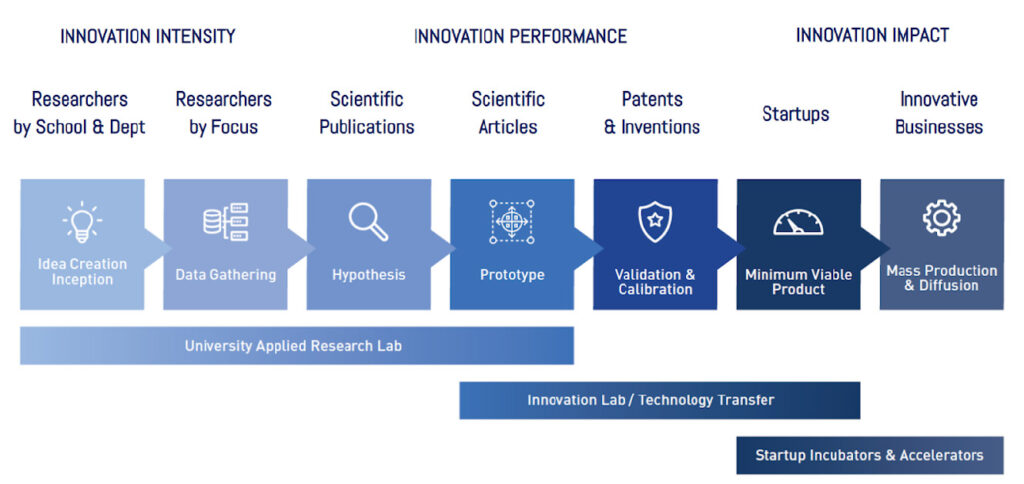
Atlas of Innovation Districts. (© Aretian Urban Analytics and Design).
The first platform, University Applied Research Lab, focuses on the first four phases of innovation (Human scale); Idea Creation Inception, Data Gathering, Hypothesis and Prototype. These University Applied Research Labs help researchers formulate ideas and lead them towards a prototype.
The second platform, Innovation Centers & Labs / Technology Transfer, covers the fourth, fifth and sixth phases of innovation; Prototype, Validation & Calibration, and Minimum Viable Product. Those Innovation Centers & Labs / Technology Transfers accompany researchers who have established a prototype in order to help them polish those prototypes into minimum viable products (MVPs).
The third platform, Startup Incubators & Accelerators, covers the last two phases of innovation; Minimum Viable Product and Mass Production & Diffusion. These Startup Incubators & Accelerators help entrepreneurs grow their companies from a mere startup with one minimum viable product to the mass production and diffusion of this product, as well as help with the development of new products and the development of the companies themselves to reach the following stage.
In the following table is an in-depth description of the 7 phases of innovation of the Network of Talent:
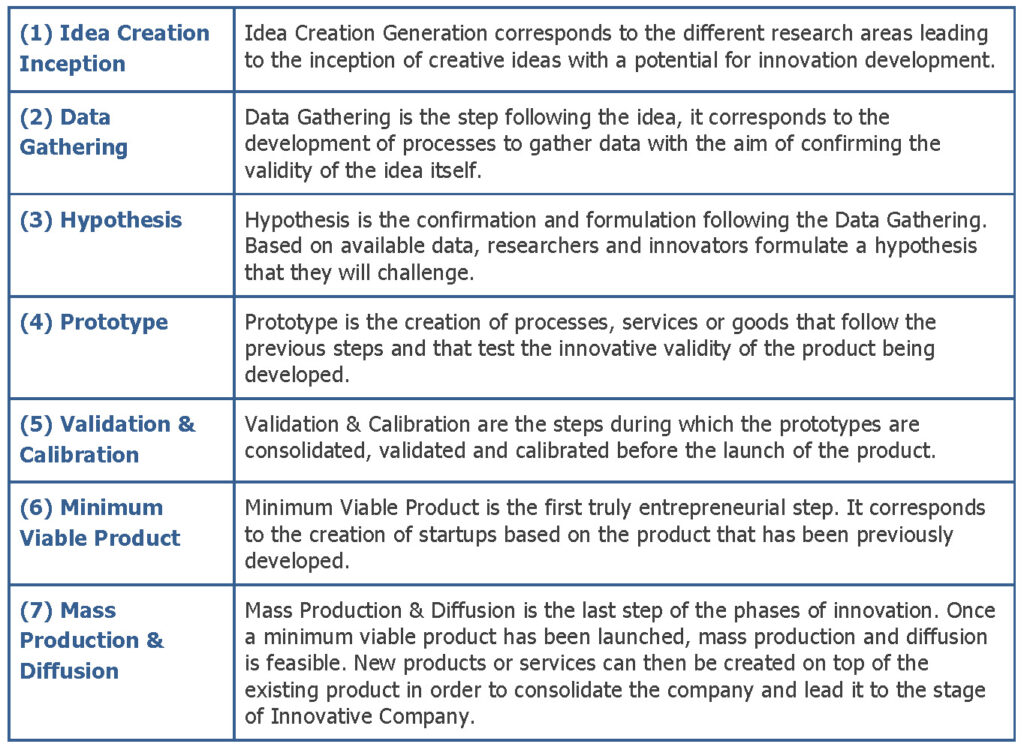
Innovation KPIs by Phase
City science research developed by Aretian at Harvard presents a series of Key Performance Indicators (KPIs) in order to gauge the maturity of a district and its innovation potential to become a true anchor for its environment. In this case, we studied the KPIs of the leading Research Institutions by following the seven phases of Innovation to the letter, which correspond to (1) Idea Creation and Inception, (2) Data Gathering, (3) Hypothesis, (4) Prototype, (5) Validation & Calibration, (6) Minimum Viable Product, and lastly (7) Mass Production & Diffusion. The descriptive statistics gathered from leading universities and research centers enable us to describe as sophisticated proxies those seven steps: (1) Researchers by School & Department, (2) Researcher by Focus, (3) Scientific Publications, (4) Scientific Articles, (5) Patents and Inventions, (6) Startups, and lastly (7) Innovative Companies, following the Aretian KPIs which were systematically measured and deployed when analyzing other notable innovation districts.
The first two Phases of Innovation, (1) Idea Creation Inception, and (2) Data Gathering, are related to the effort carried out by Researchers by School & Department, and Researcher by Focus Area. Those metrics serve as the basis for the Key Performance Indicator of Innovation Intensity, a variable measuring the collective effort deployed to create knowledge networks. Innovation Intensity is measured as a percentage of employees working on knowledge intensive activities per geographic unit. Our research shows that the average community in the United States has an Innovation Intensity of less than 12%, while Innovation Districts typically operate at or above 25%. The top-performing Innovation Districts are high-intensity environments: the top 10% have an Innovation Intensity of 50% and above, while the top 1% reach 85-95%.
The following three Phases of Innovation (3) Hypothesis, (4) Prototype, and (5) Validation & Calibration describe the knowledge advancement output in terms of Scientific Publications, Scientific Articles, and Patents and Inventions, respectively. Those metrics serve as the basis for the Aretian Key Performance Indicator of Innovation Performance, a KPI measuring the tangible results of the collective effort deployed to create knowledge advancement. Innovation Performance measures the tangible outputs of innovation created on an annual basis by the innovation community, preferably at the smallest possible census geographic aggregation level. Innovation Performance measurements reflect the output of new products, services and production processes, new patents and their associated revenues, scientific research papers, and other R&D outputs.
The last two Phases of Innovation (6) Minimum Viable Product, and (7) Mass Production & Diffusion describe the positive societal impact generated by innovation activities, in terms of Startup creation, and knowledge advancement in Innovative Companies. Such metrics serve as the basis for the Aretian Key Performance Indicator of Innovation Impact, a KPI measuring the societal benefits of the collective effort deployed to create knowledge and innovation networks. Innovation Impact describes the benefits to the broader community that result from the development of knowledge-intensive activities. Innovation Impact is measured through a variety of contributing indicators, including the number of innovation-intensive employees in the district, the meritocracy index, the prosperity index, the inequality index, measurements of indirect employment generation, measurements of diversity, and industry alignment with the broader metropolitan area.
By creating the right innovation focused environment, a given city has the potential to boost the nonlinear effects of the geographic concentration of knowledge intensive activities. In fact, an increase in 2.4x factor in Knowledge Intensive Employment in consolidated / mature innovation districts represents, on average, a broad benefit to society through the following metrics:
- 4x more inventions per employee,
- 16x more knowledge-intensive employment per resident, and
- 25x more business revenue (wealth) created per resident.
Innovation KPIs by PhasExample of port innovation district: Norfolk Naval Shipyard Technology and Innovation Lab. (The Atlas of Innovation Districts. Accessed via: https://www.aretian.com/atlas).
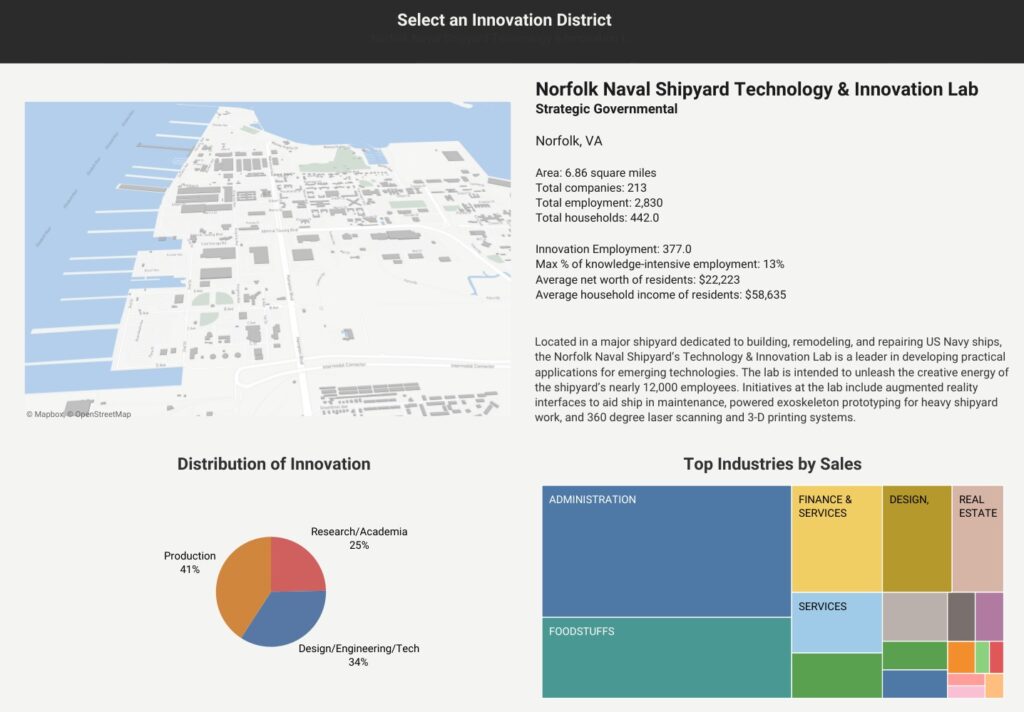
Example of port innovation district: Seattle South Lake Union. (The Atlas of Innovation Districts. Accessed via: https://www.aretian.com/atlas).
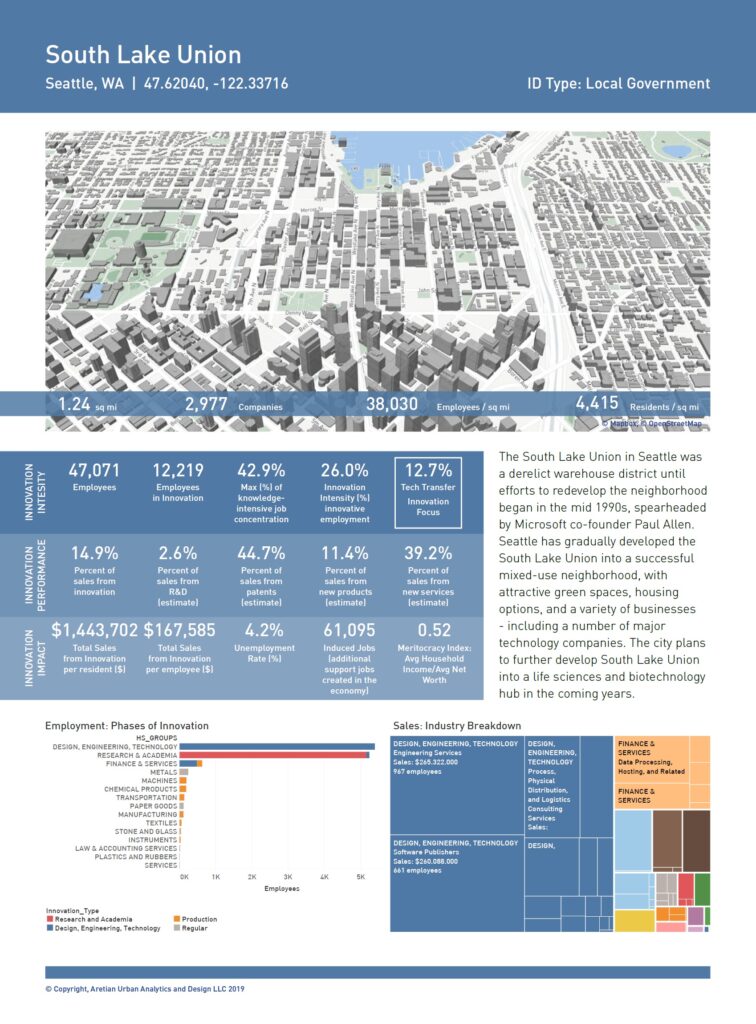
Example of port innovation district: Boston Seaport. (The Atlas of Innovation Districts. Accessed via: https://www.aretian.com/atlas).
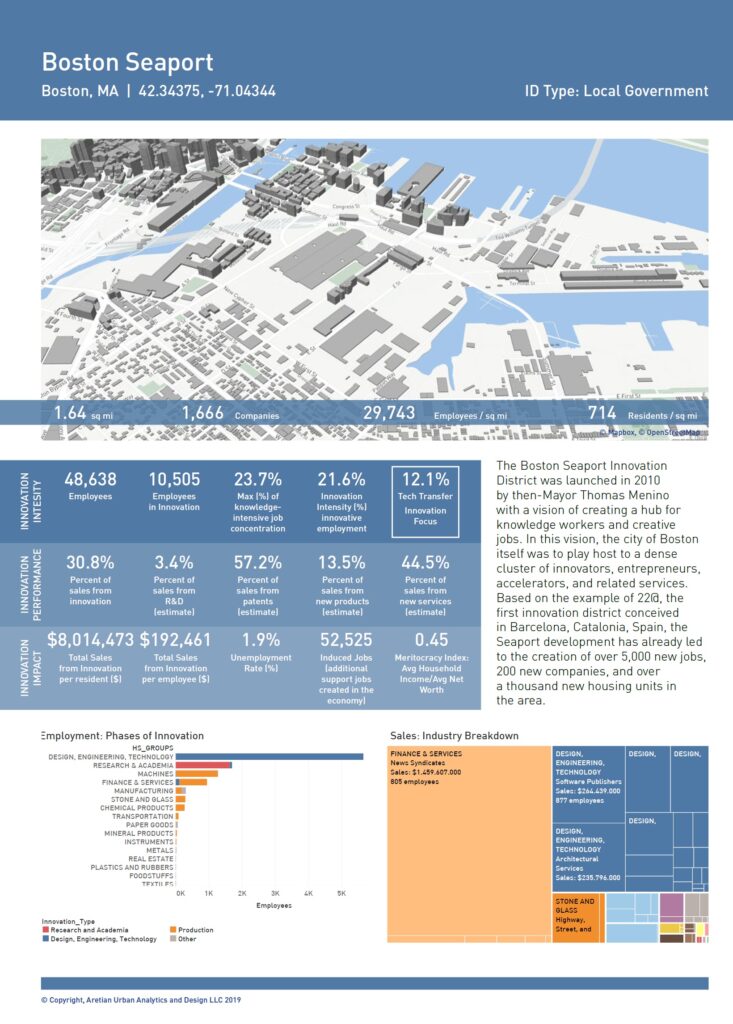
The Three Main Types of Innovation Districts Hosted in Port Environments
In our research, we observe three main types of innovation districts hosted in port environments, aiming to realize the multiplying effects of the geographic concentration of knowledge-intensive activities. Each type of port innovation district emphasizes a set of strategic advantages derived from operating an urban regeneration strategy within a maritime hub environment.
1) Advanced Manufacturing Hubs in Port Environments
The first typology involved ports hosting high value-added advanced manufacturing industrial processes within the port authority or in close vicinity. The combination of the surplus presented by the intermodal logistics consolidation opportunities, and a series of industrial manufacturing processes, International success stories range from the Port of Rotterdam Makers’ District facilitating the synergies between knowledge creation centers and production facilities, Hamburg, Bremerhaven, the military industrial complex and blue economy hub of Norfolk, Virginia (USA), Seattle’s SoDo (South of Downtown) Innovation District and its satellite, the the up-and coming Bellingham Innovation Hub in the Greater Seattle Area, and the alliance between AltaSea and Space X to shape an innovation district within the Port of Los Angeles.
2) Urban Regeneration for Port Authorities hosting knowledge hubs
A second type of port innovation districts entail those that undergo profound urban regeneration processes, involving not only the physical transformation of port authority infrastructure, but also an evolution from industrial and logistics into intangible services. Representative examples of Knowledge Hub Port Innovation Districts include Boston Seaport District (focused on digital design and services hub, hosting innovation centers from companies such as Autodesk, Amazon, Red Hat, PWC, Reebok, Vertex Pharmaceuticals, as well as Worcester Polytechnic Institute), Toronto’s Waterfront Innovation Centre, NYC’s Seaport District and Roosevelt Island (hosting the highly successful Cornell Tech campus), Tallinn’s Port Innovation District, the Knowledge Quarter in Liverpool and Canary Wharf – the Finance innovation district based in London.
3) Advanced Intermodal Logistics Hubs
Finally, a third alternative focuses on envisioning, designing, building and operating advanced intermodal logistics hubs, by means of technologies such as robotics, automation, and port authority service digitization. Some representative examples include the Panama Canal, Singapore, and Hong Kong & Cathay Hub. The advanced intermodal logistics hubs hosted in port innovation districts benefit from the most recent technology advances in order to reinforce the degree of centrality of the port authority and its surrounding knowledge ecosystem.
Hence, every port city can strategically benefit from considering the type of innovation district that could eventually be nurtured, hosted, and developed in order to , thus raising the level of competitiveness of the local economy, and boosting the professional opportunities for local citizens and international talent alike. Cities that have historically hosted major ports, such as New Orleans, Genoa, San Francisco, Venice, or Bristol, among many others, could benefit from urban regeneration processes involving the conception of port innovation districts.
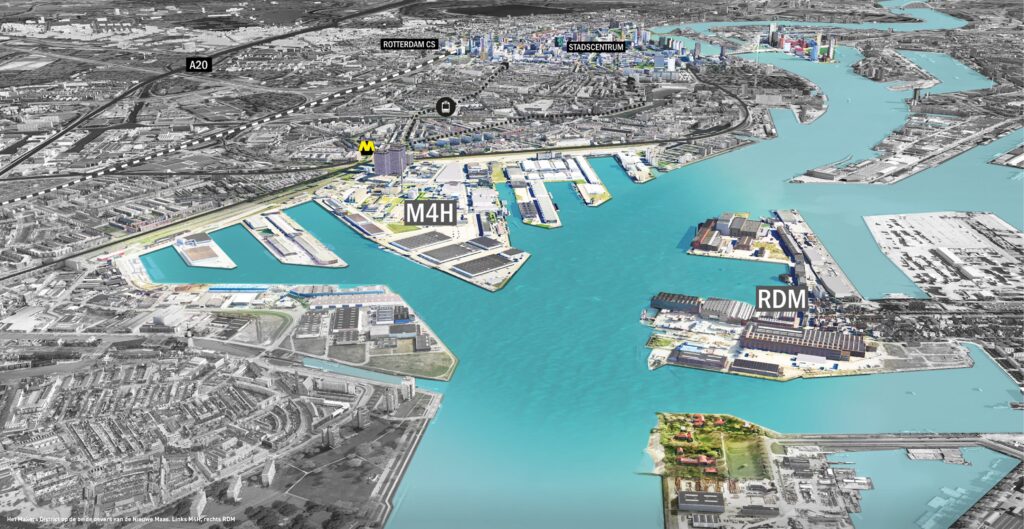
Rotterdam Makers District. (© SITE urban development, DELVA Landscapes Architecture Urbanisme).
HEAD IMAGE | Rotterdam Makers District. (© John Gundlach, 2015).
╝
REFERENCES
Burke, J. and Gras, R. The Atlas of Innovation Districts. Accessed via: https://www.aretian.com/atlas/.
Burke, J. and Gras, R. Hacia una nueva ciencia para entender y diseñar mejor las ciudades. MIT Technology Review. Accessed via: https://www.technologyreview.es/s/11355/hacia-una-nueva-ciencia-para-entender-ydisenar-mejor-las-ciudades/.
Burke, J., Gras, R., Yu, F., and Kruguer, J. (2021), ‘Multiplying effects of urban innovation districts. Geospatial analysis framework for evaluating innovation performance within urban environments’, in Advances in Science, Technology and Innovation (Dordrecht: Springer).
Rotterdam Maker’s District
https://www.rotterdammakersdistrict.com/images/RDM_makersdictrict_brochure.pdf/.